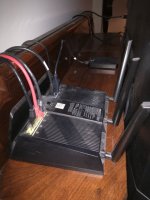I don`t want to get re-involved in this long, old discussion, but just to put the facts in one location:
- The router will start disabling CPU cores if the temperature reaches 100C. So no, it won`t burn itself out overnight, Broadcom has thermal management implemented. Core shutdowns will be logged in the System Log.
- In the initial 386 release, Asus disabled the CPU Wait instruction on the RT-AC86U, which led to a significant temperature increase. It was done at the recommendation of the CPU manufacturer to address a specific issue (no, I don`t know what that issue was), not just because they wanted to annoy their customers (so, take down those tin foil hats)
- Since it was causing some people to hit that 100C limit, Asus has since re-enabled support for the CPU Wait instructions on that model.
- My firmware has always had it enabled in official releases, only alpha/beta builds had it disabled for a while.
- Anything between 65 and 85C is perfectly normal for that CPU. Other models with a similar CPU also tend to run at around that temperature. It's what it was designed to operate at.
- If YOUR router is hitting 95-100C right now, you have an airflow issue, or a hardware issue, as other people with the exact same router model are running it at around 80C. Make sure you provide adequate cooling (don`t put it on top of a cable modem within a closed cabinet!). If it does get sufficient airflow, then your router has a hardware problem, most likely related to poor thermal contact between the heatsink and the CPU.




